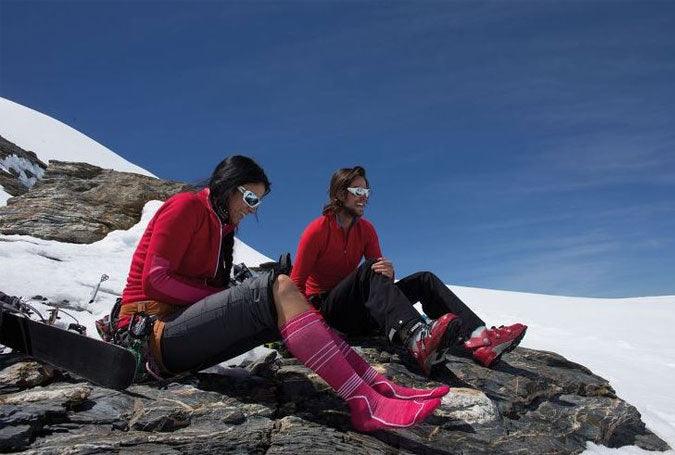
Merino Wool Vs. Synthetic Socks
Part of a good combination with fit of footwear, socks ensure warmth, comfort and performance of hiking boots, running shoes, ski boots.
Moisture management control is one of the main factors for your feet in socks during sporting activity. Moisture management includes sweat from your feet, moisture in the air, and any water that may have leaked through your hiking boots. Once feet are wet it can lead to cold and uncomfortable feet. To aid in moisture control and help to keep your feet at their best you should buy socks made for outdoor activities made from materials such as wool, synthetics and cotton mix.
Avoid wearing 100% cotton socks for hiking, tramping, walking, biking, skiing and snowboarding. Cotton absorbs and holds onto water like a sponge, causing uncomfortable wet feet and blistering. Alternatively another natural material such as merino wool is a great choice for socks in activity as they manage moisture, body odour and temperature better than all other fabrics, both man-made and natural. If you are allergic to wool fibre then another alternative to cotton is synthetic socks.

The main benefit of buying a sport specific sock is the fit around your feet. Activity specific socks, designed for hiking, skiing or snowboarding have been designed in mind ensuring support and snug fit so that the sock doesn’t move around inside your hiking boot or ski boot. Well-fitted socks designed for your particular outdoor activity won’t bunch up or slide around, which results in less blistering and more comfort for your feet.
Merino vs Synthetic properties:
- Synthetic is lighter, cheaper, more durable, dries quicker, and offers good warmth and odour control.
- Merino wool is generally more comfortable, offers superior odor control, and is naturally wicking.
- Merino wool is that it is renewable whereas the synthetic products are a by-product of oil.
- Wool is flame resistant, making for great benefits in relation to camp fires and cooking over open flame whereas polyester of any make is highly flammable

There are various pros and cons that make up the argument of whether to wear merino wool or synthetic socks during sporting activity. In conclusion merino wool is warmer, breathes better than most synthetics, and is naturally wicking and naturally anti-bacterial making it odour resistant- where as synthetic is not. Synthetic is cheaper, dries approximately 50% quicker than wool and has a better warmth to weight ratio, although it feels cooler and “clammy” when wet because it is lighter and more air permeable. Wool takes longer to feel wet because it naturally absorbs the moisture inside the fibre whereas moisture on synthetic fibre runs across it. Most synthetic materials receive a treatment to ensure they adequately transport moisture, but in untreated or worn areas the material begins to retain moisture. Ultimately for hiking, walking and tramping we would advise Icebreaker merino socks for men and women; the main purpose of being naturally wicking, therefore keeping active feet dryer and warmer for longer. For skiing and snowboarding we would advise that you wear Icebreaker Merino Socks for warmth in the colder climate however synthetic could be considered as an alternative option.



